Update:
2006-08-08 06:22 PM -0700
TIL
Medicinal Plants of Myanmar
Poaceae
compiled by U Kyaw Tun, U Pe Than, and staff of TIL. Not for sale.
Contents of this page
Family: Poaceae
6 entries
•
Poaceae family - general
characters ('Monocotyledoneae')
• Arundo donax
• {a.lo-kyu}

• Cymbopogon citratus
• {sa.pa:ling hing:-mhwé:}
 /
/
{moan.hing:hka: sa.pa:ling}
 / Lemon grass
/ Lemon grass
• Cymbopogon martinii
• {mrak-krak-thwun}

-- after Myet-kyet-thun of Chklist
• Cymbopogon nardus
• {sa.pa:ling hsi-mhwé:}
 /
/
{hsap-pra sa.pa:ling}
 / Citronella grass
/ Citronella grass
• Cymbopogon schoenanthus
• {sa.pa:ling (mhwé:)}

• Phragmites karka
• {kyu}

• Arundo spp.
• Cymbopogon
spp. /
• Cymbopogon names
• Phragmites spp.
Main Index of DB |
Top
Contents of this page
Poaceae family - general
characters ('Monocotyledoneae')
From: Families yielding important phytopharmaceuticals in
Fundamentals of Pharmacognosy and Phytotherapy, by Michael Heinrich, J.
Barnes, S. Gibbons, and E. Williamson, October 2003, ISBN:0443071322, pp.320 --
www.fleshandbones.com/readingroom/pdf/747.pdf
The ‘grass’ family is not very important with respect to their bioactive
contents, but many pharmaceuticals contain starches derived from corn, rice or
wheat as excipients.
Important medicinal plants from the family
• Zea mays L. (maize, corn) and other cereals, a common staple food;
starches are also used in antidiarrhoeal preparations.
Morphological characteristics of the family
Most are herbs, often with rhizomes, and sometimes perennial. The leaves are
distichous (with a single leaf at each node and the leaves of two neighbouring
nodes disposed in opposite position), elongate with parallel main veins and
often with a characteristic sheath at the base.
A typical feature of the family is the wind-pollinated flowers, which form
spike-like inflorescences (panicles).
Distribution
This cosmopolitan family has about 9000 species. Many of the economically
important food staples are from this family and are grown all over the world.
Chemical characteristics of the family
Members of this family often accumulate silicates and some members have
fruits rich in polysaccharides (starch) and proteinaceous tissue, mostly in the
endosperm.
Contents of this page
Family: Poaceae
Ref. Burmese-Myanmar transcripts:
• Agri.Dept.2000 63-1687:
 {a.lo-kyu} - for A. donax
{a.lo-kyu} - for A. donax
• Chklist: Alo-kyu, Kyu, Kyu-ma
• LSR 483:
 {a.lo-kyu} - for A. donax
{a.lo-kyu} - for A. donax
• FAO : NL
• KS-TMN 102: Kyu, Kyu-ma, Alo-kyu
- for A. donax
• Nagathein 1-133:
 (
( )
{kyu (a.lo-kyu)} - for A. donax . See also 4-053
)
{kyu (a.lo-kyu)} - for A. donax . See also 4-053
• UHM 07: Alokyu - for A. donax
Myanmar-Script Spelling :
• Official Myanmar Dictionaries:
 {kyu}
-
{kyu}
-
 --
TravPo-M-Dict 022
--
TravPo-M-Dict 022
 {kyu}
-
species of reed, Arundo donax -- Myan-Engl-Dict 028
{kyu}
-
species of reed, Arundo donax -- Myan-Engl-Dict 028
 )
{a.lo-kyu} -
n. kind of reed with medicinal properties, Arundo donax --
Myan-Engl-Dict 593
)
{a.lo-kyu} -
n. kind of reed with medicinal properties, Arundo donax --
Myan-Engl-Dict 593
UKT: Arundo donax according to Nagathein 1-133 and 4-053 is
 (
( )
{kyu (a.lo-kyu)}.
)
{kyu (a.lo-kyu)}.
Note by Nagathein 1- 133 : free translation by UKT: "There are two kinds of
 {kyu} or "reed", one large (major) and the other small (minor),
and both are hollow between nodes. The major reed has longer internodal
sections than the minor. The larger one or major reed is the true
{kyu} or "reed", one large (major) and the other small (minor),
and both are hollow between nodes. The major reed has longer internodal
sections than the minor. The larger one or major reed is the true
 {a.lo-kyu}. There is another kind of
{a.lo-kyu}. There is another kind of
 {kyu}. The internodal sections are not hollow. This kind is referred to as "deaf reed"
{kyu}. The internodal sections are not hollow. This kind is referred to as "deaf reed"
 {kyu-na:ping:}."
{kyu-na:ping:}."
Chklist data:
• Arundo donax L. Habit: Grass. Distribution: Reported from
Myanmar. Common Names: Alo-kyu, Kyu, Kyu-ma, Nana cane, Spanish cane
• Arundo donax var. versicolor (Mill.) Stokes. Habit: Grass.
Distribution: Reported from Myanmar. Common Names: Kyu, Kyu-ma
Hindi :
Sanskrit :
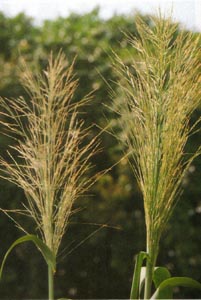
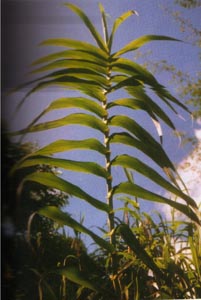 English common name used in Myanmar:
English common name used in Myanmar:
• Agri.Dept.2000 63-1687: NG
• Chklist: Nana cane, Spanish cane
• LSR 483: NG
• FAO : NL
• KS-TMN 102: Great Reed
• Nagathein 1-133: Giant Reed, See 4-053: not given
• UHM 07: NG
Picture:
• Leader from
http://aquat1.ifas.ufl.edu/arudon.jpg
• Photos: left -- habit, right -- habit with flowers,
Click on the pictures to enlarge. -- KS-TMN
• Drawing: left -
http://aquat1.ifas.ufl.edu/arudon2.jpg ; right - MB-SG
p33 and p46 (the same photo was presented on both pages.)
Plant identification characters:
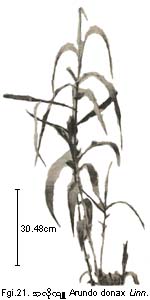
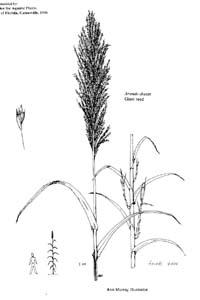
• A perennial herb, 2-3 metres tall; culms (stems) stout, erect, terete,
internodes fistular, nodes solid, tumid, the bases form runners; roots
adventitious, fibrous. Leaves alternate, simple, solitary at the nodes,
2-ranked, ligules hyaline, hirsute; bases sheathing, the sheaths envelop and
overlap the culm, longitudinally grooved, glabrous, the blades linear-lanceolate,
flat, the bases cuneate, the amrgins entire, the tips acuminate, the surfaces
glabrous. Inflorescences in terminal panicles bearing spikelets, each 3- to 4-
flowered, subtended by 2 glumes, membranous, persistent. Florets bracteate,
pedicellate, bisexual zygomorphic, hypogynous. Lower glumes elliptic, green,
pubescent; upper glumes elliptic, green, pubescent; lemmas lanceolate, awned,
green; palea lanceolate, hyaline, membranous, subtends the floret; lodicules 2,
ovate. Androecium polyandrous, stamens 3, the filaments short, iserted, the
anthers dithecous, basifixed, introrse, dehiscence longitudinal. Pistill 1,
ovary ovoid, glabrous, 3-carpelled, syncarpous, 1-loculed, the placentation
basal, the ovule solitary in the locule, the styles 2, united at the base,
exserted, the stigmas bifurcate, plumose. Fruit a caryopsis, ovoid, yellow;
seeds endospermic, copious. Flowering period: October-November.
Fruiting period: December. -- KS-TMN
• A tall stout perennial grass, stem creeping below,
leaf base amplexicaul, panicle erect thyrsiform, spikelets
3-4 flowered -- UHM
Distribution in Myanmar :
• Grows wild along coastal water edges of Myanmar. -- KS-TMN
• Naga Hills altitude 5000-8000 feet -- UHM
Part used and uses:
• Metrorrhagia;
Carminative;
Angina pain;
Dysuria;
Vaginitis;
Herpes; Disinfectant of urine; Promotes
spermatogenesis;
Asthma; As an expectorant. -- KS-TMN
• Rhizome. Emollient, diuretic, stimulate menstrual
discharge and diminish the secretion of milk -- UHM
Constituents :
• 1. 0.028 % graminine (donaxine).
2. A new alkaloid donaxarine (14) -- UHM
Contents of this page
Syn.
Andropogon citratus
Family: Poaceae
MMPDB2006: {moan.hing:hka: sa.pa:ling}

- Lemon grass (Chklist)
See also:
Cymbopogon schoenanthus
• {sa.pa:ling (mhwé:)}
 • Nagathein 1-370
• Nagathein 1-370
Burmese-Myanmar transcripts :
• Agri.Dept.2000 16-0411:
 {sa.pa:ling hing:-mhwé:}
{sa.pa:ling hing:-mhwé:}
• Chklist: Sabalin
• LSR 149:
 {sa.pa:ling (hing:sa:)}
{sa.pa:ling (hing:sa:)}
• FAO : NL
• KS-TMN : NL
• Nagathein 1-370:
 {sa.pa:ling}
{sa.pa:ling}
• UHM 19: Sabalin
• U San Hla 398:
 {sa.pa:ling}.
{sa.pa:ling}.
UKT: U San Hla on p398 listed under
 {sa.pa:ling} the following: A. citratus DC., A.
schoenanthus , C. citratus Stapf, C. nardus. Since,
C. citratus and C. nardus are different in the smell of the
oil, and the texture of the leaf surfaces, it is obvious that U San Hla cannot
be relied on with respect to botanical names.
{sa.pa:ling} the following: A. citratus DC., A.
schoenanthus , C. citratus Stapf, C. nardus. Since,
C. citratus and C. nardus are different in the smell of the
oil, and the texture of the leaf surfaces, it is obvious that U San Hla cannot
be relied on with respect to botanical names.
See the following in :
• Lemongrass (the original article)
from:
http://www.hort.purdue.edu/newcrop/med-aro/factsheets/LEMONGRASS.html
• Lemon grass (Cymbopogon citratus)
(the original article)
from:
http://www.puralibre.com/html/eng_lemon_grass.html#StudiesandReferences
• Myanmar-Script Spelling :
Official Myanmar Dictionaries :
 {sa.pa:ling}
{sa.pa:ling}
 -- TravPo-M-Dict 080
-- TravPo-M-Dict 080
 {sa.pa:ling} - n. lemon grass, Cymbopogon citratus -- -- Myan-Engl-Dict 103
{sa.pa:ling} - n. lemon grass, Cymbopogon citratus -- -- Myan-Engl-Dict 103
Chklist data:
• Cymbopogon citratus (DC.)
Stapf. Habit: Grass. Distribution: Cultivated. Common Names: Lemon grass, Sabalin
Hindi :
• {a.ga.ni. Ga.hsa~} -- Nagathein
• Ghandhatrana; Hari-chaha; Agingas. -- U San Hla
• (Indian Name:) Bhustrina or Gandhatrana
--
http://www.puralibre.com/html/eng_lemon_grass.html#StudiesandReferences
Sanskrit :
Japanese :
• レモングラス
Remon gurasu, レモン

 -- MMPND-
www.plantnames.unimelb.edu.au/Sorting/List_bot.html
-- MMPND-
www.plantnames.unimelb.edu.au/Sorting/List_bot.html
UKT: The Lemongrass oil produced by NanWinPadamya is C. citratus
レモングラス Remon gurasu,
レモン

 Remonsou:
Remonsou:
NOT C. nardus コウスイガヤ
Kou suigaya, セイロンシトロネラ
Seiron shitironera,
シトロネラ Shitoronera, シト
ロネラグラス Shitoronera gurasu.
Japanese names and scripts from:
MMPND-
www.plantnames.unimelb.edu.au/Sorting/List_bot.html
English common name used in Myanmar :
• Agri.Dept.2000 16-0411: Lemon grass
• Chklist: Lemon grass
• LSR 149: Lemon grass
• FAO : NL
• KS-TMN : NL
• Nagathein 1-370: Lemon grass
• UHM 19: Lemon grass
• U San Hla 398: True Lemon grass; Rosha grass; Sweet Rush; Ginger Grass
• MMPND: Citronella grass, Lemon grass, West Indian lemon grass. See
C. citratus (DC.) Stapf.
Sorting Cymbopogon names.
C. citratus (DC.) Stapf.(Hindi) Khawi.
(Eng) Citronella grass, Lemon grass, West Indian lemon grass.
lemongrass also lemon grass n. 1. A tropical
grass (Cymbopogon citratus) native to southern India and Sri Lanka,
yielding an aromatic oil used as flavoring and in perfumery and medicine. --
AHTD
Picture :
• Leader from LSR. Click to enlarge.
Plant identification characters :
• A very hardy plant, growing profusely in clumps. When the leaves become dry
and drop off, the plant appears almost flat. Taste: astringent, pungent. Leaves
green, pointed and coarse. -- Nagathein, free translation from Burmese by UKT.
• A tall perennial herb with sparingly branched rhizome but occasionally gives
rise to a stout erect clump up to 1.8 m high, leaf blades linear,
long attenuated towards the base and tapering to a long setaceous point. -- UHM
• " This tropical grass grows in dense clumps that can grow to 6 ft (1.8 m)
in height and about 4 ft (1.2 m) in width. The straplike leaves are 0.5-1 in
(1.3-2.5 cm) wide, about 3 ft (0.9 m) long, and have gracefully drooping tips.
The evergreen leaves are bright bluish-green and release a citrus aroma when
crushed. It is the leaves that are used as flavoring and in medicine. They are
steam distilled to extract lemongrass oil, an old standby in the the perfumer's
palette of scents. The lemongrass plants that you are likely to encounter are
cultivars and do not typically produce flowers." --
www.floridata.com/ref/C/cymb_cit.cfm
UKT: notice the phrase: "The evergreen leaves are bright bluish-green ..." .
This shows it is probably vermicelli-{sa.pa:ling}
 {moan.hing:hka: sa.pa:ling}, and is not soap-{sa.pa:ling}
{moan.hing:hka: sa.pa:ling}, and is not soap-{sa.pa:ling}
 {hsap-pra sa.pa:ling}
{hsap-pra sa.pa:ling}
Distribution in Myanmar :
• Lower Burma, Moulmein, Thaton, Mudon -- UHM
Distribution elsewhere:
• Lemongrass, a perennial herb widely cultivated in the tropics and subtropics,
designates two different species, East Indian, Cymbopogon flexuosus (DC.)
Stapf., and West Indian, Cymbopogon citratus (DC. ex Nees) Stapf. East
Indian lemongrass, also known as cochin or Malabar grass is native to India,
while West Indian lemongrass is native to southern India and Ceylon. The
lemongrasses are cultivated commercially in Guatemala, India, the People's
Republic of China, Paraguay, England, Sri Lanka, and other parts of Indochina,
Africa, Central America, and South America (11.1-73). The plant grows in dense
clumps up to 2 meters in diameter and has leaves up to 1 meter long.
--
http://www.hort.purdue.edu/newcrop/med-aro/factsheets/LEMONGRASS.html
Part used and uses :
• Carminative in flatulence colic and obstinate vomiting.
Decoction made from the leaves a diaphoretic in fever.
Good embrocation in rheumatism, lumbago and sprains. -- UHM
• As a medicinal plant, lemongrass has been considered a carminative and insect
repellent. West Indian lemongrass is reported to have antimicrobial activity
(1.8-84, 1.8-130). Oil of West Indian lemongrass acts as a central nervous
system depressant (7.6-187). Oil of East Indian lemongrass has antifungal
activity (1.8-132). The volatile oils may also have some pesticide and mutagenic
activities (11.1-96, 11.1-136).
Lemongrass is generally recognized as safe for human consumption as a plant
extract/essential oil (21 CFR section 182.20 [1982]).
--
http://www.hort.purdue.edu/newcrop/med-aro/factsheets/LEMONGRASS.html
• The grass is stimulant, diuretic, tonic, aromatic, antispasmodic and a mild
counter-irritant. It increases secretion and discharge of urine. Oil distilled
from its leaves is used for medicinal purposes. It promotes good digestion, and
a preparation of lemon grass with pepper has been used for relief of menstrual
troubles and nausea. It induces perspiration, to cool the body and reduce a
fever. Relieves spasms, muscle cramps, rheumatism and headaches.
--
http://www.puralibre.com/html/eng_lemon_grass.html#StudiesandReferences
Using Lemongrass Essential oil
• Lemongrass is very helpful for treating certain skin conditions
such as Acne, rough skin patches, open pores and the link. Many have found that
adding a few drops to OTC skin treatment products had greatly enhanced them.
Skin oils may also be made by mixing Lemongrass with Sweet almond or jojoba oil.
Used in a massage oil, Lemongrass may help headaches, stress
related conditions, muscular pain, sagging body skin, poor circulation and
muscle ton. To create a simple massage oil, use about 4 tablespoons of a light
oil such as jojoba and add 4 to 6 drops of essential oil. Mix well and apply in
a circular motion (see Aromassage Article for more information on the subject)
to spot in need of relief. Lemongrass is also gentile enough to be added to
baths, in bathoil form or straight from the bottle.
Having a fresh , green almost lemon like scent, Lemongrass can be
blended with other essential oils such as Lavender, Juniper, Rose, Geranium and
Eucalyptus. Lemongrass is a top note oil (see Perfume Making article for more
information) and will evaporate quickly in a blend. To help prevent this and add
extra aromatic qualities, pure, natural honey may be added.
--
http://www.puralibre.com/html/eng_lemon_grass.html#StudiesandReferences
Constituents :
• 1. Lemon grass oil - important constituent Citral,
2. An aldehyde C10H16O,
3. Geranic acid C16H20O2,
4. Cymol (4) -- UHM
• The quality of lemongrass oil is generally determined by the content of
citral, the aldehyde responsible for the lemon odor. Some other constituents of
the essential oils are -terpineol, myrcene, citronellol, methyl heptenone,
dipentene, geraniol, limonene, nerol, and farnesol (14.1-9). West Indian oil
differs from East Indian oil in that it is less soluble in 70 percent alcohol
and has a slightly lower citral content (14.1-9). --
http://www.hort.purdue.edu/newcrop/med-aro/factsheets/LEMONGRASS.html
Contents of this page
Family: Poaceae
MMPDB2006: {mrak-krak-thwun}

Burmese-Myanmar transcripts :
• Agri.Dept.2000 : NL
• Chklist: Myet-kyet-thun, Sabalin
• LSR : NL
• FAO : NL
• KS-TMN : NL
• Nagathein : NL
• UHM : NL
UKT: I'm listing C. martinii because
Nagathein 1-370 gave 2 Hindi names: {a.ga.ni. Gaahs.} and {ro-hsa Gaahs.}.
Nagathein identified {a.ga.ni. Gaahs.} as A. citratus, and {ro-hsa Gaahs.}
as A. schoenanthus. Because of the linguistic similarity between Nagathein's
{ro-hsa Gaahs.} and MMPND's Rosha whose scientific name is
C. martinii (Roxb.)
J. F. Watson, there is a possibility that {moan.hing:hka sa.pa:ling} is
C. martinii (Roxb.)
J. F. Watson. However, from the photo from
http://www.anthemis.nl/beeldaromaethol/palmarosa.jpg , we can easily see
that the plant is certainly not {sa.pa:ling}
Myanmar-Script Spelling :
• Official Myanmar Dictionaries :
 {mrak} -
{mrak} -
 - TravPo-M-Dict
- TravPo-M-Dict
 {mrak} - n. grass; including common grass, paddy, corn, etc. - Myan-Engl-Dict
370
{mrak} - n. grass; including common grass, paddy, corn, etc. - Myan-Engl-Dict
370
 {mrak} - NL -
Myan-Ortho
{mrak} - NL -
Myan-Ortho
Chklist data:
• Cymbopogon martinii
(Roxb.) Wats. Habit: Grass. Distribution: Mandalay, Mon. Common Names: Myet-kyet-thun, Rose grass, Rusa grass, Sabalin
Hindi : Rosha, Motiya -- MMPND
Sanskrit : Rosha, Rusha.
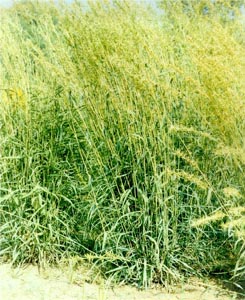
UKT: It seems that there are two varieties of C. martinii :
MMPND on
C. martinii
(Roxb.) J. F. Watson - Rosha
MMPND on C. martinii
(Roxb.) J. F. Watson var. martinii - Motiya
Nagathein 1-370 gave 2 Hindi names: {a.ga.ni. Gaahs.} and {ro-hsa Gaahs.}.
Nagathein identified {a.ga.ni. Gaahs.} as A. citratus,
and {ro-hsa Gaahs.} as A. schoenanthus.
Nagathein's {ro-hsa Gaahs.} (A. schoenanthus ) is most likely
C. martinii
(Roxb.) J. F. Watson - Rosha
English common name used in Myanmar :
• Agri.Dept.2000 : NL
• Chklist: Rose grass, Rusa grass
• LSR : NL
• FAO : NL
• KS-TMN : NL
• Nagathein : NL
• UHM : NL
English common name used elsewhere
: Geranium grass, Rosha grass. -- MMPND
Picture :
• Leader from:
http://www.anthemis.nl/beeldaromaethol/palmarosa.jpg
UKT: The plant in the photo does not look like a Poaceae. I will
have to check again.
• Photo Palmarosa-2
http://www.nrc-map.org/Photoes/palmarosa.jpg
Plant identification characters :
• Habit: Perennial; caespitose. Rootstock evident. Culms erect;
150–300 cm long. Culm-nodes flush with internodes, or swollen. Ligule an
eciliate membrane; 1.5–4 mm long. Leaf-blade base cordate, or amplexicaul.
Leaf-blades linear, or lanceolate; 25–50 cm long; 10–30 mm wide; glaucous;
aromatic. Leaf-blade margins scabrous. Leaf-blade apex attenuate; filiform.
Inflorescence: Synflorescence compound; linear, or paniculate; 15–30 cm
long; dense. Inflorescence composed of racemes; terminal and axillary; subtended
by a spatheole; enclosed. Spatheole lanceolate, or elliptic; 2–4 cm long; red.
Peduncle pubescent above... --
http://www.rbgkew.org.uk/data/grasses-db/www/imp02642.htm
Distribution in Myanmar :
Part used and uses :
• The volatile oil obtained from the
leaves of C. martinii is known in commerce as Palmarosa oil.
It has been reported that palmarosa oil from India contains geraniol
(79.2%), geranyl acetate (9.2%) and linalool (3.6%) (Shahi and Tava, 1993).
The major constituent in the oil is geraniol.
Plant source: East Indian
Components: 1: linalool (3.4%) 2: geraniol (82.9%)
3: geranyl acetate (7.0%) [Peaks 2 and 3 confirmed by GC-MS and C-13 NMR]. --
http://www.ics.trieste.it/EssentialOils/EssentialOil.aspx?ID=62
Constituents :
• Cymbopogon (Poaceae/ Graminae) represents an
important genus of about 120 species and several varieties. Cymbopogon species
are well known as a source of commercially valuable compounds like geraniol,
geranyl acetate, citral (neral and geranial), citronellal, piperitone, eugenol,
etc., which are either used as such in perfumery and allied industries, or as
starting materials for the synthesis of other products commonly used in
perfumery (Shahi and Tava, 1993). --
http://www.ics.trieste.it/EssentialOils/EssentialOil.aspx?ID=62
CYMBOPOGON MARTINI ROXB. STAPF
UKT: Further information from Internet from
www.msinp.com/herbs/palmaros.htm:
Palmarosa oil is obtained from freshly cut whole
flowering plant of Cymbopogon martinii stapf var. Motia.
The color is pale yellow, and its aroma is sweet and floral-rosy.
Physico-chemical properties:
(sp.gr.) 0.8805 to 09007 at 25 deg C; (optical rotation) [-] 0.5deg to [+}
0.75deg at 25deg C.; (ref.indx) 1.4750 to 1.4798 at 25deg C; (acid number)
0.85 to 10.5; (ester number) 15 to 48.5; (ester number after acetylation) 240
to 305; (solubility) 1.2 to 3.5 vol. of 70% alcohol; (total alcohol) 80 to
96%; (free alcohol) 62 to 84% (calculated as geraniol). Uses: (a)
For the isolation of high grade geraniol; in the cosmetics industry for
scenting of soaps; in flavoring of tobacco. (b)
Medicinal & Aromatherapy use: Antiseptic and bactericide, stomachic, relieve
the discomforts of flu and a high temperature, wrinkles, broken veins, boils,
normalize thyroid, nervous exhaustion, stress related conditions.
Synonyms :
TURKISH GERANIUM OIL (Cymbopogon martini Roxb. Stapf) India; CYMBOPOGON MARTINI ROXB. OIL INDIA; ANDROPOGON SCHOENANTHUS OIL
INDIA;
GERANIUM TURKISH OIL (Cymbopogon martini Roxb. Stapf) INDIA;
PALMAROSA OIL (Cymbopogon martini Roxb. Stapf) INDIA; CYMBOPOGON
MARTINI ROXB. STAPF OIL INDIA;
Odor Description : Sweet Rose Grassy
Appearance : Yellow Liquid
NAFTA H. # : 3301.21.0000
CAS. # : 8014-19-5
Specific Gravity : 0.88000 - 0.89400 @ 20.00 °C., 7.331 - 7.448 Pounds Per Gallon
Actual S.G. : 0.88000 @ 20.00°C., 7.331 Pounds Per Gallon
Refractive Index : 1.47100 - 1.47800 @ 20.00°C.
Actual R.I. : 1.47100 @ 20.00°C.
Melting Point : N/A
Boiling Point : N/A
Blends Well With : Coumarin; Clove; Cassia;
Terpineol; Benzyl Acetate;
Soluble in : ;
Insoluble in : ;
Some Perfumery Uses : Geranium; Tuberose; Red Rose; Soap Good & Stable; Vetiver;
Description : Palmarosa Oil is steam distilled or water distilled
mainly from wild growing, fresh or dried grass of the plant Cymbopogon martini var.
motia. The grass grows wild in India, particularly northeast
of Bombay toward the Himalaya mountains, Nepal and to a lesser extent, in
Pakistan. The grass has been planted in the Seychelle islands and in the
Comoro islands in the Indian Ocean. Palmarosa Oil is a pale yellow or pale
olive liquid with a sweet, floral rosy odor and various backnotes or topnotes
according to the quality and age of the oil. Palmarosa oil blends well with
all the conventional soap perfume materials and it forms an excellent base
with small amounts of geranium oil and oakmoss concrete or absolute.
Combinations with cananga oil, bois de rose oil, amyris oil, guaiacwood oil
make good bases for soap perfumes. The name Geranium Palmarosa is a carryover
from the days when palmarosa oil was used as an adulterant for Turkish rose
oil and was imported into Turkey for that purpose as geranium palmarosa. --
www.msinp.com/herbs/palmaros.htm
Contents of this page
Contents of this page
Family: Poaceae
MMPDB2006:
 {hsap-pra sa.pa:ling}
{hsap-pra sa.pa:ling}
- Citronella grass (Chklist)
Ref. Burmese-Myanmar transcripts:
• Agri.Dept.2000 16-0410:
 {sa.pa:ling hsi-mhwé:}
{sa.pa:ling hsi-mhwé:}
• FAO : NL
• Lè-seik-shin 145:
 {sa.pa:ling mhwé:}
{sa.pa:ling mhwé:}
• KS-TMN : NL
• Nagathein : NL
• UHM : NL
Myanmar-Script Spelling :
Official Myanmar Dictionaries :
-  {sa.pa:ling}
{sa.pa:ling}
 --
TravPo-M-Dict 080
--
TravPo-M-Dict 080
-  {sa.pa:ling} - n. lemon grass, Cymbopogon citratus -- Myan-Engl-Dict 103
{sa.pa:ling} - n. lemon grass, Cymbopogon citratus -- Myan-Engl-Dict 103
UKT: Both TravPo-M-Dict and Myan-Engl-Dict, did not list either
 {sa.pa:ling hsi-mhwé:} or
{sa.pa:ling hsi-mhwé:} or
 {sa.pa:ling mhwé:}, and therefore what is given above (from TravPo-M-Dict 080
and Myan-Engl-Dict 103) do not apply to C. nardus .
{sa.pa:ling mhwé:}, and therefore what is given above (from TravPo-M-Dict 080
and Myan-Engl-Dict 103) do not apply to C. nardus .
Hindi :
Sanskrit :
English common name used in Myanmar :
• Agri.Dept.2000 16-0410: Citronella grass
• FAO : NL
• Lè-seik-shin 145: Citronella
• KS-TMN : NL
• Nagathein Nl:
• UHM : NL
citronella n. 1. A tropical Asian grass (Cymbopogon
nardus) having bluish-green, lemon-scented leaves and an essential oil.
2. A pale yellow to brownish aromatic oil obtained from this plant, used
chiefly in perfumery and also in some insect repellents and commercial
flavorings. [New Latin from French citronnelle lemon oil, diminutive of
citron citron; See citron ] -- AHTD
Picture :
• Leader from {lèy-seik-shing:} page 145.
Click on picture to enlarge.
Plant identification characters :
• {lè~seik-shing:} page 145 on
 {sa.pa:lin mhwé:} (free translation from Burmese by UKT): Plant: similar
in appearance to annuals, height 4 to 6 feet, with a very sweet smell (Comment
by UKT: smell of cheap scented soaps available in Myanmar.). Leaf: about
3 ft long.; broad at base tapering toward apex which is pointed. Leaves dried up
at the flowering time. Leaves are much broader and bigger than
{sa.pa:lin mhwé:} (free translation from Burmese by UKT): Plant: similar
in appearance to annuals, height 4 to 6 feet, with a very sweet smell (Comment
by UKT: smell of cheap scented soaps available in Myanmar.). Leaf: about
3 ft long.; broad at base tapering toward apex which is pointed. Leaves dried up
at the flowering time. Leaves are much broader and bigger than
 {sa.pa:ling hing:sa:}. (See
C. citratus) .
Flowers: Flowering at the centre of the plant.
Flowering time is about November to January similar
to the flowers of rushes. (Comment by UKT: from the
information given on page 149 on
{sa.pa:ling hing:sa:}. (See
C. citratus) .
Flowers: Flowering at the centre of the plant.
Flowering time is about November to January similar
to the flowers of rushes. (Comment by UKT: from the
information given on page 149 on
 {sa.pa:ling hing:mhwé:},
{sa.pa:ling hing:mhwé:},
 {sa.pa:ling mhwé:} flowers more readily than
{sa.pa:ling mhwé:} flowers more readily than
 {sa.pa:lin hin:mhwé:} which rarely flower. Since I have never seen
{sa.pa:lin hin:mhwé:} which rarely flower. Since I have never seen
 {moan.hing:hka:
sa.pa:ling} flowering, I am tentatively holding the view that
{moan.hing:hka:
sa.pa:ling} flowering, I am tentatively holding the view that
 {sa.pa:ling mhwé:} of {lè~seik-shing:} is no other than soap-{sa.pa:ling}
{sa.pa:ling mhwé:} of {lè~seik-shing:} is no other than soap-{sa.pa:ling}
 which to
me has an unacceptable smell which is not at all "sweet".)
which to
me has an unacceptable smell which is not at all "sweet".)
Distribution in Myanmar :
Part used and uses :
Constituents
Contents of this page
Family: Poaceae
UKT: See also
• Cymbopogon citratus
• {sa.pa:ling hing:-mhwé:}
 • Agri.dept.2000 16-0411
• Agri.dept.2000 16-0411
• {sa.pa:ling (hing:sa:)}
 • Lè-seik-shin 149
• Lè-seik-shin 149
Ref. Burmese-Myanmar transcripts:
• Agri.Dept.2000 : NL
• FAO : NL
• Lè-seik-shin : Nl
• KS-TMN : NL
• Nagathein 1-370:
•
 {sa.pa:ling (mhwé:)}
{sa.pa:ling (mhwé:)}
• UHM : NL
Classification:
Botanical Name: Cymbopogan citratus, syn
Andropogon schoenanthus. Fam Gramineae
Indian Name: Bhustrina or Gandhatrana
Other names: French:
herbe de citron, German: Zitronengras, Italian:
erba di limone, Spanish: hierba de limon Indian:
bhustrina, sera, Indonesian: sere, serehm, Lao:
bai mak nao, Malay: serai, Sinhalese, sera,
Thai: takrai.
--
http://www.puralibre.com/html/eng_lemon_grass.html
Myanmar-Script Spelling :
Hindi : {ro-hsa Gaahs} --
Nagathein 1-370
Sanskrit :
English common name used in Myanmar :
• Agri.Dept.2000 : NL
• FAO : NL
• Lè-seik-shin : Nl
• KS-TMN : NL
• Nagathein 1-370: Scented grass
• UHM : NL
English common name used elsewhere:
Camel grass - for C. schoenanthus -- MMPND
Picture :
Plant identification characters :
• Lemon Grass is a tall
tropical grass. The fresh stalks and leaves have a clean lemon-like odour because
they contain an essential oil, which is also present in lemon peel. It is a
perennial, aromatic, tall grass with rhizomes and densely tufted fibrous roots.
It has short underground stems with ringed segments; coarse, green slightly
leathery leaves in dense clusters, terminating in a long bristly point. The
blades of the grass are about 90 cms long and 0.5 cm wide. Lemon grass contains
an essential oil. This oil is sherry colored with a pungent taste and lemon-like
odour with citral as the principal constituent. The contents of this oil varies
with the age of the grass --
http://www.puralibre.com/html/eng_lemon_grass.html
Distribution in Myanmar :
Part
used and uses :
• Andropogon schoenanthus Linn. Gramineae.
Camel's Hay. Geranium Grass. Lemon Grass. Oil-Plant.
Asia, African tropics and subtropics. This species is commonly cultivated for
the fine fragrance of the leaves which are often used for flavoring custard.
When fresh and young, the leaves are used in many parts of the country as a
substitute for tea and the white center of the succulent leaf-culms is used to
impart a flavor to curries. The tea made of this grass is considered a wholesome
and refreshing beverage, says Wallich, and her Royal Majesty was supplied with
the plant from the Royal Gardens, Kew, England.
http://www.henriettesherbal.com/eclectic/sturtevant/andropogon.html
• Curative Properties:
The grass is stimulant, diuretic, tonic, aromatic, antispasmodic and a mild
counter-irritant. It increases secretion and discharge of urine. Oil distilled
from its leaves is used for medicinal purposes. It promotes good digestion, and
a preparation of lemon grass with pepper has been used for relief of menstrual
troubles and nausea. It induces perspiration, to cool the body and reduce a
fever.Relieves spasms, muscle cramps, rheumatism and headaches.
Flatulence: Lemon grass and its oil are carminative,
valuable in relieving flatulence. It is given in doses of 3 to 6 drops
with sugar as an emulsion. The emulsion is prepared by
mixing 3 to 6 drops of common lemon grass oil with sugar.
Digestive Disorders: Lemon grass is useful in
strengthening the functions of stomach and promoting
its action. It is beneficial in the treatment of indigestion.
Lemon grass oil also treats spasmodic affections of the bowels,
gastric irritability and cholera. Fevers: The grass induces
copious perspiration and brings down temperature. It also produces
a feeling of coolness. Raw juice or decoction of the grass can also be taken.
Menstrual Disorders: An infusion of the grass, mixed with black pepper,
is given in painful and difficult menstruation. Raw juice or decoction of
the grass may be taken in such a condition.Researchers have found
that Lemongrass does hold antidepressant, anti-oxidant, astringent,
bactericidal, fingucidel, nervine and sedative properties.
It also can be used as a deodorant and body tonic.
Rheumatism and Other joint Pains: The grass is
used locally over rheumatic joints, lumbago and sprains. Lemon grass oil mixed
with twice its bulk of coconut oil is a stimulating ointment for rheumatism,
lumbago, neuralgia, sprains and other painful affections. In chronic cases, the
undiluted oil may be used for better results. It can also be taken internally in
the same manner as for fevers. Ringworm: Leaves of lemon grass are useful
in treating ringworm as a local application. A paste of the leaves made with
buttermilk should be applied on the affected part. --
http://www.puralibre.com/html/eng_lemon_grass.html
Using Lemongrass Essential oil
Lemongrass is very helpful for treating certain skin conditions such
as Acne, rough skin patches, open pores and the link. Many have found that
adding a few drops to OTC skin treatment products had greatly enhanced them.
Skin oils may also be made by mixing Lemongrass with Sweet almond or jojoba oil.
Used in a message oil, Lemongrass may help headaches, stress related
conditions, muscular pain, sagging body skin, poor circulation and muscle
ton. To create a simple message oil, use about 4 tablespoons of a light oil such
as jojoba and add 4 to 6 drops of essential oil. Mix well and apply in a
circular motion (see Aromassage Article for more information on the subject) to
spot in need of relief. Lemongrass is also gentile enough to be added to baths,
in bathoil form or straight from the bottle.
Having a fresh , green almost lemon like scent, Lemongrass can be
blended with other essential oils such as Lavender, Juniper, Rose, Geranium and
Eucalyptus. Lemongrass is a top note oil (see Perfume Making article for more
information) and will evaporate quickly in a blend. To help prevent this and add
extra aromatic qualities, pure, natural honey may be added.
Today, as with many other essential oils, it is used as
flavoring for food, alcoholic and softdrinks, a compound in soaps,
detergents and cosmetics, the fresh leaves have been traditionally used in Thai
cooking for many years to give dishes a lemon flavor. The perfume industry has
found that Lemongrass can give almost the same effect in blends as more
expensive scents such as verbena and melissa, therefore making the price of the
product less expensive. Make sure you read labels of the aforementioned
essential oils carefully to be certain they haven’t been adulterated with
Lemongrass which will diminish their effects.
--
http://www.puralibre.com/html/eng_lemon_grass.html
Studies and References
Abstract - Effect of Lemon Grass Extract on
Hepatic and Intestinal Xenobiotic-Metabolizing Enzymes
(Somsakul Thumvijit, M.S. Biochemistry)
Lemon grass
extract, a Thai medicinal plant, has been shown to inhibit chemical-induced
carcinogenesis, possibly due to modulation of xenobiotic-metabolizing enzymes.
The present study has investigated the effects of lemon grass extract and its
component (citral, geraniol, b-myrcene) on phase I xenobiotic-metabolizing
enzymes (CYP450 contents, benzo(a)pyrene hydroxylase, acetanilide-4-hydroxylase,
aminopyrine and NDMA demethylase) in liver and phase II xenobiotic-metabolizing
enzymes (glutathione-S-transferase (GST), UDP-glucuronyltransferase (UDP-GT),
and NAD(P)H: quinone oxidoreductase (QR)) in liver and intestinal mucosa of F344
rats. At 5 weeks of age, rats were fed with 2.0, 0.5, 0.1, 0.01 g/kg bw. of
lemon grass extract or 1.0, 0.1, 0.01 g/kg bw. of citral or geraniol or b-myrcene
by gavage every morning for 5 days. Rats in control groups were given an equal
volume of 25% DMSO or corn oil. Rats were killed at the end of experiment, liver
and intestine were collected to determine enzyme activities. The results showed
that phase I enzymes, aminopyrine-N-demethylase activity was significantly
increased in rat received lemon grass extract, or citral, or geraniol or b-myrcene.
Benzo(a)pyrene hydroxylase activity was increased in citral treated-rats only.
No modulating effects on other cytochrome P450 enzyme activities. It was also
found that GST, UDP-GT activities in liver and colonic mucosa and the QR
activity in small intestine were significantly elevated in rats received lemon
grass extract compared to those controls fed only vehicle. The GST, QR and
UDP-GT activities were significantly increased in the liver, small intestine and
colon of rats treated with citral, geraniol and b-myrcene, only GST in the small
intestine of geraniol treated-rats and QR in colon of b-myrcene treated- rats
showed slightly increased. It was suggested that the protection against
chemical-induced carcinogenesis of lemon grass may be due to increment of the
activities of detoxification enzymes such as GST, UDP-GT and QR in the liver and
intestines. From the results, it may be able to explain antimutagenic property
against AFB1 or inhibitory effect on AOM-induced ACF in rat colon of lemon grass
extract. Aminopyrine-N-demethylase (P450 2B) activity metabolizes AFB1 to AFQ1
which is the weaker mutagenic substance than its parent, AFB1. This enzyme
activity was increased in rats received either lemon grass extract or citral or
geraniol or b-myrcene which correlates with previous report that lemon grass
inhibited AFB1 mutagenesis. Lemon grass extract showed inhibitory effect on
azoxymethane (AOM)-induced ACF in rat colon in other previous study, possibility
due to no effect of lemon grass on P450 2E1 to metabolize AOM to form its
proximate metabolites, methylazomethanol (MAM), in liver, in addition the
enhancement of UDP-GT by lemon grass extract may lead to increase conjugation
reaction which is the detoxificating pathway of azozymethane (AOM). --
http://www.puralibre.com/html/eng_lemon_grass.html
Source:
Simon, J.E., A.F. Chadwick
and L.E. Craker. 1984. Herbs: An Indexed Bibliography. 1971-1980. The Scientific
Literature on Selected Herbs, and Aromatic and Medicinal Plants of the Temperate
Zone. Archon Books, 770 pp., Hamden, CT.
• Lemongrass, a perennial
herb widely cultivated in the tropics and subtropics, designates two different
species, East Indian, Cymbopogon flexuosus (DC.) Stapf., and West Indian,
Cymbopogon citratus (DC. ex Nees) Stapf. East Indian lemongrass, also
known as cochin or Malabar grass is native to India, while West Indian
lemongrass is native to southern India and Ceylon. The lemongrasses are
cultivated commercially in Guatemala, India, the People's Republic of China,
Paraguay, England, Sri Lanka, and other parts of Indochina, Africa, Central
America, and South America (11.1-73). The plant grows in dense clumps up to 2
meters in diameter and has leaves up to 1 meter long.
• The reported life zone for
lemongrass is 18 to 29 degrees centigrade with an annual precipitation of 0.7 to
4.1 meters with a soil pH of 5.0 to 5.8 (East Indian) or 4.3 to 8.4 (West
Indian) (14.1-9). The plants need a warm, humid climate in full sun. They grow
well in sandy soils with adequate drainage. Since the plants rarely flower or
set seed, propagation is by root or plant division. The plants are harvested
mechanically or by hand about four times each year with the productive
populations lasting between four and eight years (14.1-9). Extensive breeding
programs have developed many varieties of lemongrass.
• The quality of lemongrass
oil is generally determined by the content of citral, the aldehyde responsible
for the lemon odor. Some other constituents of the essential oils are -terpineol,
myrcene, citronellol, methyl heptenone, dipentene, geraniol, limonene, nerol,
and farnesol (14.1-9). West Indian oil differs from East Indian oil in that it
is less soluble in 70 percent alcohol and has a slightly lower citral content
(14.1-9).
• Lemongrass is used in herbal
teas and other nonalcoholic beverages in baked goods, and in confections. Oil
from lemongrass is widely used as a fragrance in perfumes and cosmetics, such as
soaps and creams. Citral, extracted from the oil, is used in flavoring soft
drinks in scenting soaps and detergents, as a fragrance in perfumes and
cosmetics, and as a mask for disagreeable odors in several industrial products.
Citral is also used in the synthesis of ionones used in perfumes and cosmetics
(11.1-73, 14.1-9).
• As a medicinal plant,
lemongrass has been considered a carminative and insect repellent. West Indian
lemongrass is reported to have antimicrobial activity (1.8-84, 1.8-130). Oil of
West Indian lemongrass acts as a central nervous system depressant (7.6-187).
Oil of East Indian lemongrass has antifungal activity (1.8-132). The volatile
oils may also have some pesticide and mutagenic activities (11.1-96, 11.1-136).
• Cymbopogon nardus
is a source of citronella oil. Cymbopogon martinii is reportedly toxic to
fungi (1.8-53).
• Lemongrass is generally
recognized as safe for human consumption as a plant extract/essential oil (21
CFR section 182.20 [1982]).
• [Note: References listed above in parentheses can be found in full in the
original reference]
Culinary Uses
Lemon grass (Cymbopogon citratus), a native of India, is widely used
in Thai and Vietnamese.This is a very pungent herb and is normally used in small amounts.
The entire stalk of the grass can be used.The grass blade can be sliced very fine
and added to soups. The bulb can be bruised and minced for use in a variety of
recipes. (see recipes).
The light lemon flavor of this grass blends well with garlic,
chilies, and cilantro. The herb is frequently used in curries as well as in
seafood soups. It is also used to make tea.
Lemon grass has an intriguing, lemony perfume without the bite that
lemons can add to a dish. The taste is refreshing and light, with a hint of
ginger. These qualities make it blend well with garlic, chiles, and cilantro --
ingredients common to the cuisines of Indonesia and Thailand. It is most often
used in curries, marinades, stews, and seafood soups as it needs liquids to
bring out its essential oils. Its citrus taste helps to lighten some of the
richer tasting dishes. Lemon grass is also used as the basis of a popular drink
in the tropics, and as a tea.
Constituents :
Contents of this page
Family: Poaceae
UKT: See also
 {a.lo-kyu}
{a.lo-kyu}
See
Classification:P. karka
Note: "Phragmites can be easily distinguished from Arundo and
Neyraudia by the silky beards at the bases of the lowest panicle branches,
which are absent in the other two (Dabadghao & Shankarnarayan, 1973)". --
http://www.fao.org/ag/AGP/AGPC/doc/GBASE/data/PF000309.HTM
Burmese-Myanmar transcript names:
• Agri.Dept.2000 06-0144:
 {kyu},
{kyu},
 {kyu-a},
{kyu-a},
 {kyu-keing:}
{kyu-keing:}
• Chklist: Kyu, Kyu-a, Kyu-kaing, Kyu-wa-kaing
• LSR : NL
• FAO : NL
• KS-TMN : NL
• Nagathein1-133/ 4-053 :
 {kyu}; listed {kyu} as Arundo donax See 4-053:
{kyu}; listed {kyu} as Arundo donax See 4-053:
 {a.lo-kyu}.
{a.lo-kyu}.
• UHM 07: NL
UKT: Nagathein 1-133 listed
 {kyu} as Arundo donax , and referred to 4-053
{kyu} as Arundo donax , and referred to 4-053
 {a.lo-kyu}.
{a.lo-kyu}.
Note by Nagathein 1- 133 : free translation by UKT: "There are two kinds of
 {kyu} or "reed", one large (major) and the other small (minor), and both are
hollow between nodes. The major reed has longer internodal sections than the
minor. The larger one or major reed is the true
{kyu} or "reed", one large (major) and the other small (minor), and both are
hollow between nodes. The major reed has longer internodal sections than the
minor. The larger one or major reed is the true
 {a.lo-kyu}. There is another kind of
{a.lo-kyu}. There is another kind of
 {kyu}. The internodal sections are not hollow. This kind is called by Myanmars
as the "deaf reed"
{kyu}. The internodal sections are not hollow. This kind is called by Myanmars
as the "deaf reed"
 {kyu-na:ping:}."
{kyu-na:ping:}."
Myanmar-Script Spelling
• Official Myanmar Dictionaries
 {kyu} -
{kyu} -
 --
TravPo-M-Dict 022
--
TravPo-M-Dict 022
 {kyu} - species of reed,
Arundo donax -- Myan-Engl-Dict 028
{kyu} - species of reed,
Arundo donax -- Myan-Engl-Dict 028
Chklist data:
• Phragmites vallatoria (L.) Veldkamp. Cited as: Phragmites karka
(Retz.) Trin. ex Steud. Habit: Grass. Distribution: Reported from Myanmar.
Common Names: Kyu, Kyu-a, Kyu-kaing, Kyu-wa-kaing
Hindi :
Sanskrit :
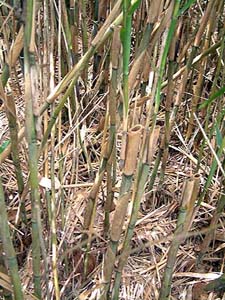
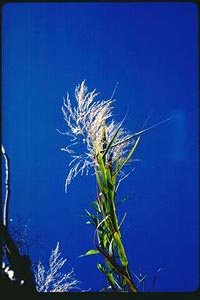
English common name used in Myanmar :
• Agri.Dept.2000 06-0144: not given for
 {kyu},
{kyu},
 {kyu-a},
{kyu-a},
 {kyu-keing:}
{kyu-keing:}
• FAO : NL
• Lè-seik-shin : NL
• KS-TMN : NL
• Nagathein 1-133/ 4-053: Giant reed for Arundo donax ; not given for Phragmites karka .
• UHM 07: NL
Picture:
• Leader from
www.city.funabashi.chiba.jp/.../ plant/0920.html
• Photo: left -
http://www.anbg.gov.au/images/photo_cd/9J18G058272/038_2.jpg
• Photo: right -
http://www.pacificworlds.com/cnmi/land/images/phragmit.jpg
Plant identification characters :
• A perennial reed with long rhizomes and robust, erect culms to 3 m.
The leaves are 15-30 cm long and nearly 2.5 cm broad; inflorescence is a large
plume-like panicle with capillary branches and small, slender spikelets. It is
leafy up the panicle. Phragmites can be easily distinguished from Arundo and
Neyraudia by the silky beards at the bases of the lowest panicle branches, which
are absent in the other two (Dabadghao & Shankarnarayan, 1973). In
New Guinea the reed occurs from near sea-level to at least 2 000 m.
It thrives in a rainfall regime from 200 to 5 000 mm in swamps (India).
It grows in standing water and is therefore tolerant of flooding.
It usually grows in clay soils ranging from strongly acid
(pH 4.5) to slightly alkaline (pH 7.5).
Natural habitat: Along streams, in wet
grassland and in swamps in Africa, India, New Guinea and northern Australia. --
http://www.fao.org/ag/AGP/AGPC/doc/GBASE/data/PF000309.HTM
Distribution in Myanmar:
Part used and uses:
Ethnobotany (Worldwide use) :
Constituents:
Contents of this page
Family: Poaceae
Results of search for 'Arundo' in the Checklist of Plants of
Myanmar, U.S. National Herbarium, 5 Aug 2006.
• Arundo donax L. Habit: Grass. Distribution: Reported from
Myanmar. Common Names: Alo-kyu, Kyu, Kyu-ma, Nana cane, Spanish cane
• Arundo donax var. versicolor (Mill.) Stokes. Habit: Grass.
Distribution: Reported from Myanmar. Common Names: Kyu, Kyu-ma
• Neyraudia madagascariensis (Kunth) Hook. f. Cited as: Arundo
madagascariensis Kunth. Habit: Bamboo. Distribution: Cultivated
USDA-NRCS
"ARTE5","Arundo tecta Walt.",">>Arundinaria gigantea ssp.
tecta","Poaceae"
"ARUND4","Arundo L.","giant reed","Poaceae"
"ARDO4","Arundo donax L.","giant reed","Poaceae"
"ARDOV","Arundo donax L. var. versicolor (P. Mill.) Stokes",">>Arundo
donax","Poaceae"
"ARVE2","Arundo versicolor P. Mill.",">>Arundo donax","Poaceae"
"ARSE10","Arundo semiannularis Labill.",">>Rytidosperma
semiannulare","Poaceae"
"ARFE7","Arundo festucacea Willd.",">>Scolochloa festucacea","Poaceae"
Contents of this page
Family: Poaceae
UKT:
• The following species are of interest to settle the question what
 {moan.hing:hka: sa.pa:ling} is:
Cymbopogon citratus,
C. flexuosus , C. martinii ,
C. nardus ,
C. schoenanthus
{moan.hing:hka: sa.pa:ling} is:
Cymbopogon citratus,
C. flexuosus , C. martinii ,
C. nardus ,
C. schoenanthus
Results of search for 'Cymbopogon' in the Checklist of Plants
of Myanmar, U.S. National Herbarium, 12 Apr 2006.
• Cymbopogon citratus (DC.)
Stapf. Habit: Grass. Distribution: Cultivated. Common Names: Lemon grass, Sabalin
• Cymbopogon clandestinus (Nees ex Steud.)
Stapf. Habit: Grass. Distribution: Reported from Myanmar -
Common Names: Myet-sat, Scented grass
• Cymbopogon coloratus (Hook. f.) Stapf.
Habit: Grass. Distribution: Mandalay. Common Names: Sedan, Thapangaing
• Cymbopogon flexuosus
(Nees ex Steud.) J.F. Watson. Habit: Grass. Distribution: Mandalay - Common Names: Sabahn
• Cymbopogon gidarba (Buch.-Ham. ex Steud.)
A. Camus. Habit: Grass. Distribution: Reported from Myanmar
• Cymbopogon gidarba var. burmanicus
Bor. Habit: Grass. Distribution: Reported from Myanmar
• Cymbopogon khasianus (Munro ex Hack.) Stapf
ex Bor. Habit: Grass. Distribution: Bago
• Cymbopogon mandalaiaensis Soenarko. Habit:
Grass. Distribution: Reported from Myanmar
• Cymbopogon martinii
(Roxb.) Wats. Habit: Grass. Distribution: Mandalay, Mon. Common Names: Myet-kyet-thun, Rose grass, Rusa grass, Sabalin
• Cymbopogon microstachys (Hook. f.) Soenarko.
Habit: Grass. Distribution: Reported from Myanmar
• Cymbopogon nardus
(L.) Rendle. Cited as: Andropogon nardus L. Habit: Grass. Distribution: Cultivated. Common Names: Citronella grass, Kaingbyu-mi,
Myet-hmwe, Sabalin-hmwe, Singu-myet
• Cymbopogon nervatus (Hochst.) Chiov.
Habit: Grass. Distribution: Reported from Myanmar
• Cymbopogon pendulus (Nees ex Steud.) Wats.
Habit: Grass. Distribution: Magway
• Cymbopogon polyneuros (Steud.) Stapf. Habit:
Grass. Distribution: Mandalay. Common Names: Myet-kyet-thun
• Cymbopogon schoenanthus
(L.) Spreng. Habit: Grass. Distribution: Mandalay, Shan
• Cymbopogon traninhensis (A. Camus) S.
Soenarko. Habit: Grass. Distribution: Reported from Myanmar
• Cymbopogon virgatus Stapf ex Bor - Habit:
Grass. Distribution: Wide. Common Names: Myet-nan, Myet-sat
USDA-NRCS-data
"CYMBO","Cymbopogon Spreng.","
lemon grass","Poaceae"
"CYCI","Cymbopogon citratus (DC. ex Nees)
Stapf","lemon grass","Poaceae"
"ANCI4","Andropogon citratus DC. ex Nees",
">>Cymbopogon citratus","Poaceae"
"CYDI13","Cymbopogon distans (Nees)
J. F. Watson","","Poaceae"
"CYFL2","Cymbopogon flexuosus (Nees ex Steudel)
J. F. Watson","east indian
lemongrass","Poaceae"
"ANFL7","Andropogon flexuosus Nees ex
Steudel",">>Cymbopogon
flexuosus","Poaceae"
"CYJW","Cymbopogon jwarancusa (Jones)
Schultes","Iwarancusa grass","Poaceae"
"CYMA15","Cymbopogon martinii (Roxb.)
J. F. Watson","rosha grass","Poaceae"
"ANMA17","Andropogon martinii Roxb.","
>>Cymbopogon martinii","Poaceae"
"CYNA","Cymbopogon nardus (L.) Rendle",
"citronella grass","Poaceae"
"ANNA4","Andropogon nardus L.",
">>Cymbopogon nardus","Poaceae"
"CYRE","Cymbopogon refractus (R. Br.) A.
Camus","barbwire grass","Poaceae"
"CYSC8","Cymbopogon schoenanthus (L.) Spreng.
[excluded]","camel grass","Poaceae"
"CYTO3","Cymbopogon tortilis (J. Presl) A.
Camus","","Poaceae"
"CYWI6","Cymbopogon winterianus Jowitt",
"cymbopogon grass","Poaceae"
Agri.Dept.2000
Cymbopogon citratus -- Gramineae -- {sa.pa:ling (hing:mhwé:)} 16-0411
Cymbopogon clandestinus -- Gramineae -- {mrak-sap} 47-1235
Cymbopogon nardus -- Gramineae -- {sa.pa:ling (hsi-mhwé:)} 16-0410
Cymbopogon virgatus -- Gramineae -- {mrak-nan°} 47-1240
UKT: The following is from
http://www.hort.purdue.edu/newcrop/med-aro/factsheets/LEMONGRASS.html
LEMONGRASS
Family: Poaceae (Gramineae), Cymbopogon species
Source:
Simon, J.E., A.F. Chadwick and L.E. Craker. 1984. Herbs: An
Indexed Bibliography. 1971-1980. The Scientific Literature on Selected Herbs,
and Aromatic and Medicinal Plants of the Temperate Zone. Archon Books, 770 pp.,
Hamden, CT.
• Lemongrass, a perennial herb widely cultivated in the tropics and subtropics,
designates two different species, East Indian, Cymbopogon flexuosus (DC.)
Stapf., and West Indian, Cymbopogon citratus (DC. ex Nees) Stapf. East
Indian lemongrass, also known as cochin or Malabar grass is native to India,
while West Indian lemongrass is native to southern India and Ceylon. The
lemongrasses are cultivated commercially in Guatemala, India, the People's
Republic of China, Paraguay, England, Sri Lanka, and other parts of Indochina,
Africa, Central America, and South America (11.1-73). The plant grows in dense
clumps up to 2 meters in diameter and has leaves up to 1 meter long.
The reported life zone for lemongrass is 18 to 29 degrees centigrade with an
annual precipitation of 0.7 to 4.1 meters with a soil pH of 5.0 to 5.8 (East
Indian) or 4.3 to 8.4 (West Indian) (14.1-9). The plants need a warm, humid
climate in full sun. They grow well in sandy soils with adequate drainage. Since
the plants rarely flower or set seed, propagation is by root or plant division.
The plants are harvested mechanically or by hand about four times each year with
the productive populations lasting between four and eight years (14.1-9).
Extensive breeding programs have developed many varieties of lemongrass.
The quality of lemongrass oil is generally determined by the content of
citral, the aldehyde responsible for the lemon odor. Some other constituents of
the essential oils are -terpineol, myrcene, citronellol, methyl heptenone,
dipentene, geraniol, limonene, nerol, and farnesol (14.1-9). West Indian oil
differs from East Indian oil in that it is less soluble in 70 percent alcohol
and has a slightly lower citral content (14.1-9).
Lemongrass is used in herbal teas and other nonalcoholic beverages in baked
goods, and in confections. Oil from lemongrass is widely used as a fragrance in
perfumes and cosmetics, such as soaps and creams. Citral, extracted from the
oil, is used in flavoring soft drinks in scenting soaps and detergents, as a
fragrance in perfumes and cosmetics, and as a mask for disagreeable odors in
several industrial products. Citral is also used in the synthesis of ionones
used in perfumes and cosmetics (11.1-73, 14.1-9).
As a medicinal plant, lemongrass has been considered a carminative and insect
repellent. West Indian lemongrass is reported to have antimicrobial activity
(1.8-84, 1.8-130). Oil of West Indian lemongrass acts as a central nervous
system depressant (7.6-187). Oil of East Indian lemongrass has antifungal
activity (1.8-132). The volatile oils may also have some pesticide and mutagenic
activities (11.1-96, 11.1-136).
Cymbopogon nardus is a source of citronella oil. Cymbopogon
martinii is reportedly toxic to fungi (1.8-53).
Lemongrass is generally recognized as safe for human consumption as a plant
extract/essential oil (21 CFR section 182.20 [1982]).
Last modified 6-Dec-1997
[Note: References listed above in parentheses can be found in full
in the original reference].
Aromatic and Medicinal Plants Index |
Purdue Guide to Medicinal and Aromatic Plants
Contents of this page
Edited by UKT: Some authors listed under Andropogon
Sorting Cymbopogon names - Internet download 060413
Multilingual Multiscript Plant Name Database (MMPND)-
www.plantnames.unimelb.edu.au/Sorting/List_bot.html
Species in this section
( A = names approved by most authorities,
s = approved as synonyms) :
C. afronardus Stapf ->
C. nardus (L.) Rendle
C. citratus
(DC.) Stapf (name approved by most authorities)
C. flexuosus
(Nees ex Steud.) J. F. Watson
C. jwarancusa (Jones) Schult.
C. jwarancusa (Jones) Schult. x C. nardus
(L.) Rendle var. confertiflorus ( Steud. ) Stapf ex Bor
C. martini
Stapf -> C. martinii (Roxb.) J. F. Watson
C. martinii (Roxb.) Stapf var. motia ->
C. martinii (Roxb.) J. F. Watson var. martinii
C. martinii (Roxb.) J. F. Watson
C. martinii (Roxb.) J. F. Watson var. martinii
C. martinii (Roxb.) J. F. Watson var. sofia hort.
C. nardus (L.) Rendle
C. refractus (R. Br.) A. Camus
C. schoenanthus (L.) Spreng.
C. tortilis (Presl) Hitchc.
C. validus (Stapf) Burtt Davy ->
C, nardus (L.) Rendle
C. winterianus Jowitt.
References
Citronella grass,
Ginger grass and Lemon grass
by UKT.
I came to the website by the University of Melbourne while trying to
determine what common English name should be applied to the oil produced by
water distillation of
 {sa.pa:ling}, a Cymbopogon species, that is solely used for the preparation of
{sa.pa:ling}, a Cymbopogon species, that is solely used for the preparation of
 {moan.hing:hka:} or Burmese vermicelli . There are three candidates for a
name: Citronella grass, Ginger grass and Lemon grass. These names are found
to have been applied to following species.
{moan.hing:hka:} or Burmese vermicelli . There are three candidates for a
name: Citronella grass, Ginger grass and Lemon grass. These names are found
to have been applied to following species.
Citronella grass is applied to the following:
• C, citratus (DC.) Stapf.,
SYNONYM(S) : A, citratus DC., C, citratus (DC.
ex Nees) Stapf
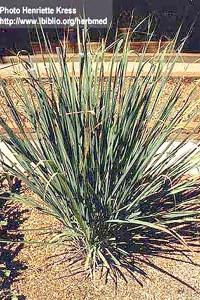
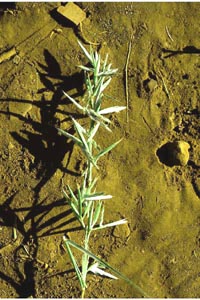 • C, nardus (L.) Rendle
• C, nardus (L.) Rendle
SYNONYM(S): A, nardus L., C, afronardus Stapf,
C, validus (Stapf) Burtt Davy
See also C.
jwarancusa (Jones) Schult x C. nardus (L.) Rendle var.
confertiflorus (Steud.) Stapf ex Bor
Nagathein 1-370 identified C. citratus as
 {sa.pa:ling}.
However, the Hindi name (in Romabama) given in Nagathein is {a.ga.ni. Ga.hsa~}
-- not "Khawi".
{sa.pa:ling}.
However, the Hindi name (in Romabama) given in Nagathein is {a.ga.ni. Ga.hsa~}
-- not "Khawi".
• Photo: left - spike
http://plants.usda.gov/cgi_bin/topics.cgi?earl=plant_profile.
cgi&symbol=CYMBO&photoID=cymbo_001_ahp.tif
• Photo: right - clump
www.ibiblio.org/herbmed/pictures/p04/pages/cymbopogon-citratus.htm
• In October 2005, Dr. Thin Nwè Win, a colleague of mine, brought back
from Bangkok, Thailand, a sample of Cymbopogon oil (
http://www.buytropicalife.com ,
sales@tropicalife ) labeled
"Lemongrass, Cymbopogon citratus", which smells exactly like

 {moan.hin:hka: sa.pa:lin}, which lends a clue to what the Myanmar
{moan.hin:hka: sa.pa:lin}, which lends a clue to what the Myanmar

 {moan.hin:hka: sa.pa:lin} is.
{moan.hin:hka: sa.pa:lin} is.
Ginger grass is applied to the following:
• C, martinii (Roxb.) J. F.
Watson var. sofia hort.
Lemon grass is found to have been applied to the following species:
• C, citratus (DC.) Stapf.
SYNONYM(S) : A, citratus DC., C, citratus (DC. ex Nees) Stapf
• C, flexuosus (Nees ex Steud.)
J. F. Watson
SYNONYM(S): A, flexuosus Nees ex Steud.
Cymbopogon citratus (DC.) Stapf.
SYNONYM(S) : A, citratus
DC., C, citratus (DC. ex Nees) Stapf
CHINESE : 柠檬草 Ning meng cao,
香茅 Xiang mao, 香茅草 Xiang mao cao.
DUTCH : Citroengras.
ENGLISH : Citronella grass, Lemon grass, West Indian lemon grass.
FRENCH : Verveine des Indes, Citronnelle.
GERMAN : Lemongras, Zitronengras.
HINDI : Khawi.
JAPANESE : レモングラス
Remon gurasu, レモン

 Remonsou.
Remonsou.
KOREAN : 레몬그라스.
MALAY : Serai, Serai makan, Sereh (Indonesia), Sereh makan (Indonesia).
NEPALESE : Pirhe ghaans.
Pirhe ghaans.
PORTUGUESE : Erva-cidreira.
RUSSIAN : Лимонное
сорго.
SINHALESE : Sera.
SPANISH : Limonaria (Argentina), Malojillo, Te de limon (Honduras), Pasto
cedrón (Argentina), Pasto-limón (Argentina), Zacate-limón (El Salvador),
Zacate-dete.
SWEDISH : Citrongräs.
TAGALOG : Tanglad.
THAI : ตะไคร้ Ta khrai.
VIETNAMESE : Sà.
Cymbopogon exaltatus (R. Br.) Domin
SYNONYM(S): A. exaltatus R. Br.
ENGLISH : Australian lemongrass.
FRENCH : Herbe citronnée.
GERMAN : Ostindisches Zitronellagras.
Cymbopogon flexuosus
(Nees ex Steud.) J. F. Watson
SYNONYM(S) : A. flexuosus Nees ex Steud.
CHINESE: 印度尼西
亚香茅 Yin du ni xi ya xiang mao,
香茅草 Xiang mao cao
柠檬草 Ning meng cao,
柠檬香茅 Ning meng xiang mao.
DANISH: Indisk citrongræs.
ENGLISH: Cochin grass, East Indian
lemon grass, Lemon grass, Malabar grass.
FRENCH: Citronnelle en herbe, Herbe de Malabar.
GERMAN: Ostindisches Zitronengras, Malabargras.
KOREAN: 레몬그라스.
SPANISH: Pasto de Malabar.
Cymbopogon jwarancusa (Jones) Schult.
SYNONYM(S): A. jwarancusa Jones
CHINESE: 泥泊尔草 Ni bo er cao.
ENGLISH: Iwarancusa grass, Iwarancusa grass
NEPALESE:
 Dhadhdii (Dhaddi),
Dhadhdii (Dhaddi),
 Urvaa.
Urvaa.
Cymbopogon jwarancusa (Jones) Schult. x
Cymbopogon nardus (L.) Rendle var.
confertiflorus (Steud.) Stapf ex Bor
SYNONYM(S): A. jwarancusa
Jones x A. confertiflorus Steud.
CHINESE: 玫瑰草 Mei gui cao.
ENGLISH: Jamarosa, Jamrosa oil plant.
JAPANESE: ジャマロー
サ Jamaroosa, ジャマ
ローサグラス Jamaroosa gurasu.
Cymbopogon martinii
(Roxb.) J. F. Watson
SYNONYM (S) : A. martini Roxb.,
A. schoenanthus L. var. martinii L. Hook. f.,
C. martini Stapf
CHINESE : 玫瑰草 Mei gui cao.
DUTCH : Indische geranium.
ENGLISH : Geranium grass, Rosha grass.
GERMAN : Palmarosa, Rosen Palmarosagras.
HINDI: Rosha. (UKT: See
C.martinii )
JAPANESE : パルマロサグ
ラス Parumarosa gurasu, パル
マローザ Parumarooza.
KOREAN : 팔마로자,
팔마로사
RUSSIAN : Пальм
ороза, Ци
мбопогон
Мартини.
SANSKRIT : Rosha, Rusha.
SPANISH : Palmarosa.
Cymbopogon martinii
(Roxb.) J. F. Watson var. martinii
This "var." which could be a form or a group is
considered as a synonym of the basic species. Accordingly
it shares many common names.
SYNONYM(S): C. martinii (Roxb.) Stapf var.
motia hort.
DUTCH : Oost-Indische geranium, Turkse geranium.
ENGLISH : East-Indian geranium, Geranium grass,
Motia oil plant, Palmarosa oil plant, Turkish geranium.
FRENCH : Herbe à senteurs de geranium, Herbe à senteurs de geranium Rosat.
GERMAN : Rosen Palmarosagras.
HINDI : Motiya.
SANSKRIT : Motiya.
SWEDISH : Palmorosgräs.
Cymbopogon martinii (Roxb.) J. F. Watson var.
sofia hort.
This "var." which could be a form or a group is
often overlooked and sometimes wrongly considered as a
synonym of the basic species.
DUTCH : Gembergras.
ENGLISH : Gingergrass.
FRENCH : Herbe à senteurs de geranium,
Herbe à senteurs de geranium Rosat.
GERMAN : Gingergras.
SANSKRIT : Sofiya.
SWEDISH : Ingefäragräs.
Cymbopogon nardus (L.) Rendle
SYNONYM(S) : A, nardus L., C. afronardus
Stapf, C. validus (Stapf) Burtt Davy
CHINESE : 亚香
茅 Ya xiang mao.
DANISH : Citronella, Lenabatugræs.
DUTCH : Citroenmelisse.
ENGLISH : Ceylon citronella, Citronella grass,
Geranium grass, Nardus grass.
FRENCH : Citronelle, Citronnelle de Ceylan.
GERMAN : Ceyloncitronell, Citronellgras, Nardusgras.
ITALIAN : Citronella di Ceylon.
JAPANESE: コウスイガヤ
Kou suigaya, セイロンシ
トロネラ Seiron shitironera,
シトロネラ Shitoronera,
シトロネラグ
ラス Shitoronera gurasu.
KOREAN : 시트로넬라 .
POLISH : Palczatka szczetna.
PORTUGUESE : Citronela de Ceilan, Citronela do
Ceilão (Brazil), Lenabatu (Brazil).
RUSSIAN : Цитро
нелла, По
меранце
вая трава.
SPANISH : Zacate limón.
SWEDISH : Citronellagräs.
THAI : ตะไค
ร้หอม Ta khrai hom.
VIETNAMESE : Củ sả.
Cymbopogon refractus
(R. Br.) A. Camus
SYNONYM(S): A. refractus R. Br.
ENGLISH : Barbwire grass, Soap grass.
Cymbopogon schoenanthus
(L.) Spreng.
SYNONYM(S): A, schoenanthus L.
ENGLISH : Camel grass.
FRENCH : Herbe des chameaux, Citronnelle de Madagascar .
PORTUGUESE: Capim-cheiroso (Brazil), Capim-cidreira (Brazil), Capim-cidrilho
(Brazil), Capim-ciri (Brazil), Capim-de-cheiro (Brazil), Capim-limão (Brazil).
SPANISH : Pasto de camellos.
Cymbopogon tortilis (Presl) Hitchc.
JAPANESE : オガルカ
ヤ Ogarukaya, オカ
ルカヤ Okarukaya.
Cymbopogon winterianus Jowitt.
CHINESE : 爪哇香茅
Zhao wa xiang mao, 拉丁美洲
香茅 La ding mei zhou xiang mao.
DANISH : Ægte citrongræs.
ENGLISH : Java citronella grass.
FRENCH : Citronelle de Java.
GERMAN : Java Citronellgras, Java Zitronengras, Maha-Pengiri-Gras.
ITALIAN : Citronella di Giava.
KOREAN : Awaiting feedback.
PORTUGUESE : Citronela de Java (Brazil), Maha pengiri (Brazil).
RUSSIAN : Цитро
не лловое.
SPANISH : Pasto de camellos.
Contents of this page
Family: Poaceae
Results of search for 'Phragmites' in the Checklist of
Plants of Myanmar, U.S. National Herbarium, 5 Aug 2006.
• Phragmites vallatoria (L.) Veldkamp. Cited as: Phragmites karka
(Retz.) Trin. ex Steud. Habit: Grass. Distribution: Reported from Myanmar.
Common Names: Kyu, Kyu-a, Kyu-kaing, Kyu-wa-kaing
USDA-NRCS
"PHMA30","Phragmites macer Munro",">>Hakonechloa macra","Poaceae"
"PHRAG","Phragmites Adans.","reed","Poaceae"
"PHAU7","Phragmites australis (Cav.) Trin. ex Steud.","common reed","Poaceae"
"PHAUB","Phragmites australis (Cav.) Trin. ex Steud. var. berlandieri (Fourn.)
C.F. Reed",">>Phragmites australis","Poaceae"
"PHCO15","Phragmites communis Trin.",">>Phragmites australis","Poaceae"
"PHCOB","Phragmites communis Trin. ssp. berlandieri (Fourn.) A.& D. Löve",">>Phragmites
australis","Poaceae"
"PHCOB2","Phragmites communis Trin. var. berlandieri (Fourn.) Fern.",">>Phragmites
australis","Poaceae"
"PHPH4","Phragmites phragmites (L.) Karst.",">>Phragmites
australis","Poaceae"
"PHKA3","Phragmites karka (Retz.) Trin. ex Steud. [excluded]","tall
reed","Poaceae"
Contents of this page
Entry format: Botanical name / Family / Ref. Burmese-Myanmar
transcripts • Agri.Dept.2000 :
• Chklist: • LSR : • FAO : • KS-TMN:
• Nagathein :
• UHM :/ Myanmar-Script Spelling (
• Official Myanmar Dictionaries : - TravPo-M-Dict - Myan-Engl-Dict -
Myan-Ortho / Chklist data / Hindi /
Sanskrit / English common name used in Myanmar /
Picture / Plant identification characters /
Distribution in Myanmar / Part used and uses /
Constituents /
End of TIL file
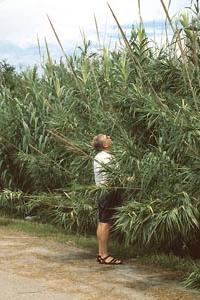




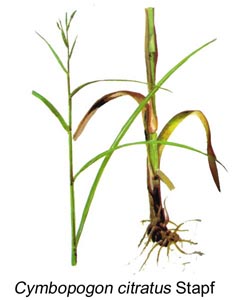
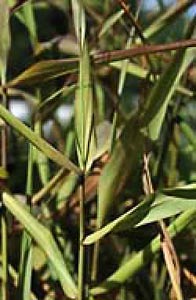

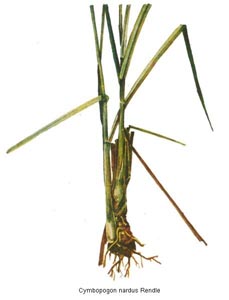
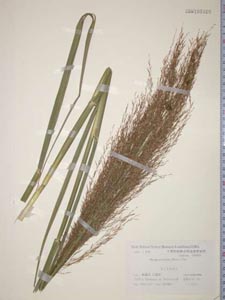



 •
•